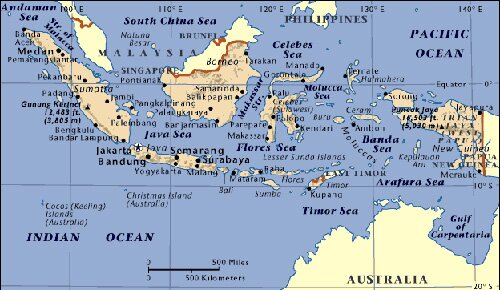El mapa del mundo desde la perspectiva post-colonial: Indonesia y Oceanía
Indonesia actually covers two continents, of which the borderline runs through the deep waterway between Bali and Lombok, where the so-called “Wallace Line” is located. To the east of this line we can find kangaroos and other marsupials, just like in Australia, but not to the western side of it
When, in 2005, I received the exciting news about my transfer from Berlin as Dutch ambassador to Jakarta, the first thing I did was to go to the well-known Berlin bookshop of Dussmann in the Friedrichstrasse to look for travel guides about Indonesia
Contrary to what I had expected, I could not find any book on Indonesia in the section dealing with Asia and Southeast Asia. I kept searching and to my surprise finally found what I had been looking for in the section on Oceania and the Pacific.
Only then did I fully realize that Indonesia actually covers two continents, of which the borderline runs through the deep waterway between Bali and Lombok, where the so-called “Wallace Line” is located. To the east of this line we can find kangaroos and other marsupials, just like in Australia, but not to the western side of it.
The reason is clear: When sea levels were much lower in the past, these very special animals could not cross the sea because it remained too deep for them. As a result, quite divergent developments took place on both sides, also in the field of flora. These deep straits did not, however, prevent human beings and their cultures from migrating all over the area that is today called the Indonesian Archipelago.
Generally it can be said that the geographic boundaries of Indonesia with its huge territory and extraordinarily rich diversity, have not been determined by ethnicity, culture, religion, language, nor its belonging to one or more continents, but rather by its Dutch colonial history. The Dutch colonial boundaries in the end became the political boundaries of the Republic of Indonesia.
Not one inch more and not one inch less. I do not want to say that there is any merit in the Dutch contribution to the unity of Indonesia. It is just a result of colonial history, which did not follow any logical ethnic or other boundaries. The Dutch just tried to get control of a large area to serve their own interests, both strategic and economic.
Many people argue that present day Indonesia experienced 350 years of Dutch colonialism. This is true, although it is not valid for the whole territory of Indonesia. Some areas had only been fully colonized since the early 20th century, which in some cases means that full colonial occupation lasted some 35 instead of 350 years.
In the early 17th century the Dutch occupied small parts of what today is Indonesia, with the main purpose of lucrative trade in, for instance, spices like nutmeg, which were found in the remote Banda Islands. This spice trade, conducted by the United East Indies Company (Vereenigde Oostindische Compagnie — VOC), was the beginning of a development that finally led to that huge colonial empire, called the Dutch East Indies or Nederlands Indië, which stretched over an area of over 5,300 kilometers (which is similar to the distance from Bremen, in Germany, to the western borders of China).
The northern region of Aceh was one of the areas occupied by the Dutch in the beginning of the 20th century, after a bloody war of some 30 years. Had Aceh not been occupied and incorporated into the Dutch East Indies, it might now have been a separate Sultanate, like for instance Brunei, not part of the Republic of Indonesia. The same applies to the Batak region in Northern Sumatra, as well as to Bali, which were equally only incorporated in the early 20th century.
In the absence of Dutch domination in Northern Sumatra in the late 19th century, the German Lutheran Church had the chance to convert many Batak people there and to establish the Batak Christian Protestant Church.
Similarly, German protestant missionaries introduced Christianity to Papua in 1855. Later on, with the expansion of Dutch colonialism in Papua, it was agreed between Christian missionaries that Papua was to be divided into a Catholic and Protestant zone of influence.
Just imagine how pragmatic the missionaries were at the time, by deciding that the northern part of West Papua was to be Protestant and the southern part Catholic! I am sure that in Europe such things did not go that smoothly.
As a result of all these developments, and many more, the Indonesia of today has become even more highly diverse than it already was.
The present situation therefore carries all kinds of residues of earlier colonialism, even in the sphere of religion.
People in Germany may have been brought up with a perception and a political map of Asia and Oceania that differs somewhat from that of the Dutch, particularly because of our different colonial histories, Germany being more
oriented toward Oceania.
Throughout the centuries the Dutch have generally given more attention to the Asian area (because of their colonies there), even though Australia was first discovered by a Dutchman in 1606, and the whole Australian continent was called Nieuw Holland (New Holland) from 1650 till 1817.
Former German colonies in the East were particularly located in Oceania, for instance in North Eastern Papua, a fact that is hardly known in the Netherlands, even though the Dutch colonized the western part of Papua, which made Germany and the Netherlands neighbors at the time in both Europe as well as in Oceania.
Colonial backgrounds are often reflected in the art collections of the former colonizing countries. When I looked in Berlin for Indonesian treasures in the Ethnological Museum in Dahlem, I found a rich collection of most beautifully decorated boats from Oceania, but I could not detect anything of Indonesian origin.
In Dutch museums it is, obviously, the other way around. When visiting the Tropical Museum in Amsterdam with my parents as a small child, I became familiar with Indonesian gamelan music and Sumatran dances, as a result of which I have been fascinated by Indonesia’s rich cultural heritage ever since.
The colonial past is occasionally also clearly reflected in our diplomatic relations. When I started in Jakarta, the Dutch Embassy there was still our biggest diplomatic mission in the world, whereas the Belgian Embassy was among the smallest.
On the other hand, the Belgian Embassy in Kinshasa, Congo, is very important to Belgium, but ours is of minor importance.
Looking at it objectively: Indonesia is a very important country in the world, having a strategic location with respect to China, a population of over 240 million people, a stable democracy, a fast growing economy and being a serious candidate member of the BRIC countries.
We usually take the Western democratic orientation of Indonesia for granted, but just imagine how different the Asian region might have looked if the Indonesian Communist Party had succeeded in taking power in Indonesia in 1965.
For many years, the biggest number of European political visits to Indonesia used to be from the Netherlands. Whereas I hardly had to encourage or stimulate this development, the French ambassador to Jakarta, on the other hand, complained to me at the time that he had to, more or less, beg Paris to pay more political attention to Indonesia.
All of this had nothing to do with the objective importance of Indonesia, but rather with our historic pasts, whether colonial or not. For the French Algeria is, for instance, of high political relevance. For Belgium it is Congo. For Portugal, East Timor or Timor Leste is relevant, and so on. For the Netherlands it is obviously Indonesia (and Surinam).
It goes without saying that in the Dutch public mind, also China and Japan are considered to be highly relevant, particularly from an economic point of view. And it is only logical that we devote ourselves to these countries in order to best serve our economic and political interests.
Fewer people in the Netherlands are aware, however, that, when it comes to Dutch exports, the German federal states of Bavaria and Baden-Württemberg are much more important than China and Japan together; just like North Rhine-Westphalia, to which our exports are bigger than to the whole world outside Europe.
In fact, some countries are in our perception more important than they would perhaps deserve to be from an “objective” point of view. But objectivity is a relative concept, which cannot be based on economic factors alone.
(The writer Nikolaos van Dam was ambassador of the Netherlands to Indonesia, Germany, Turkey, Egypt and Iraq. The article is excerpted from a lecture he delivered in German on the occasion of the 112nd celebration of the East Asia Society in Bremen, Germany, recently)
Título original: The world map through post-colonial eyes: Indonesia
Fuente: Nikolaos van Dam para Jakarta Post / Foto: internationalsos, mapquest /
Selección: JLJL


